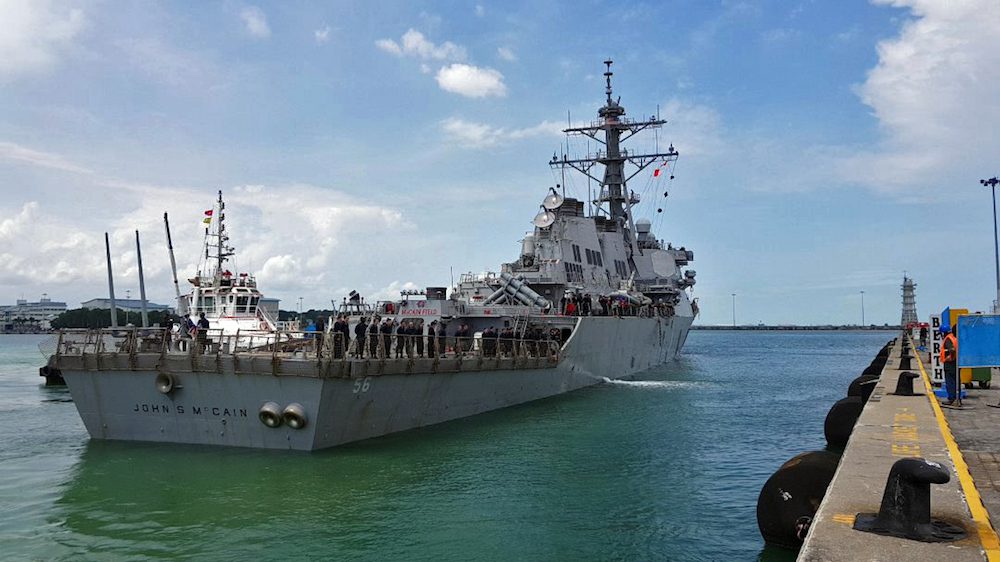The guided-missile destroyer USS John S. McCain (DDG 56) arrives pier side at Changi Naval Base, Republic of Singapore following a collision with the merchant vessel Alnic MC while underway off Singapore. U.S. Navy Photo
The U.S. Navy has already taken action to prevent future mishaps involving its ships at sea, including turning on the Automatic Identification Systems of its vessels in high-traffic areas.
The Navy’s new policy on transmitting AIS was revealed by the Navy’s Chief of Naval Operations Admiral John Richardson during questioning following his testimony before the Senate Armed Services Committee this week on the recent incidents involving Navy Surface Fleet ships. The incidents include the deadly collisions involving USS Fitzgerald and USS John S. McCain as well as two earlier incidents, one of which was a collision.
Under U.S. and international regulations, nearly all ships are required to carry Automatic Identification Systems that automatically transmit key information about the ship – such as vessel identity, type, position, course, speed, navigational status and other safety-related information – so that info can be picked up other ships, coastal authorities, or aircraft.
Under U.S. law, however, warships and other Government vessels are not required to use AIS, even though almost all Navy ships are equipped with a functioning AIS system – it just happens to be turned off.
You may recall that following the Fitzgerald and McCain collisions, AIS animations of the incidents only included information for the merchant vessels, leaving the tracks of the warships a mystery in both cases.
When asked by committee member Senator Angus King of Maine about the technology available to Navy sailors and other ships to help with collision avoidance, Admiral Richardson responded that the Navy has taken action to turn the AIS systems on its vessels back on, particularly in high-traffic areas.
“The other question is about these ships that ran into us,” said Senator King, referring to the merchant vessels involved in the collisions. “Is there some technology that they couldn’t see us? Are we using a stealth technology?”
“Sir, it wouldn’t surprise anybody that we design our warships to have a low radar cross-section, some even designed to be very low, so that degree of stealth makes us more effective from a war-fighting standpoint,” said Admiral Richardson. “But that also imposes a burden, if you will, on the crew of that ship to understand that they are low-observable, to understand that they might not be seen as something that is as large as a destroyer. It will have a radar cross-section of a ship that is much smaller.”
“Or they are not in a conflict situation, that they emit some kind of signal,” said Senator King.
Admiral Richardson continued:
“That’s been an immediate action. There is this Automatic Identification System, AIS. We had, I think, a distorted perception of operational security that we kept that system secure – off – on our warships. One of the immediate actions following these incidents is that, particularly in heavily trafficked areas, we’re just going to turn it on.”
“In heavily trafficked areas like off Japan?”, asked Senator King.
“Right. You can look outside and see the ship, so, it’s not an operational security standpoint,” said Admiral Richardson.
The guided-missile destroyer USS John S. McCain (DDG 56) was involved in a collision with the merchant vessel Alnic MC while underway east of the Straits of Malacca and Singapore on August 21, killing ten sailors. In June, seven sailors were killed when the USS Fitzgerald collided with a containership off the east coast of Japan. Other recent incidents include the grounding of the USS Antietam (CG 54) in January and a collision between the USS Lake Chaplain (CG 57) and a South Korean fishing vessel in May.
In response to the accidents, U.S. Chief of Naval Operations Admiral Richardson has been tasked with conducting a comprehensive review of the Navy’s global surface fleet operations.
Whether or not these incidents could have been avoided if the ships’ were transmitting AIS info is yet to be determined by the investigations into each of the accidents.
The Senate Armed Services Committee is led by Chairman Senator John McCain (R-AZ) and Ranking Member Senator Jack Reed (D-RI).

 Join The Club
Join The Club











